The German-Italian coproduction Quo vadis? (Georg Jacoby, Gabriellino D'Annunzio, 1924-1925) was the third silent film based on the historical novel of the same name, written by Nobel Prize-winning novelist Henryk Sienkiewicz. Emil Jannings, famous star of the German silent cinema, was cast as the evil emperor Nero.
![André Habay]()
German postcard by Ross Verlag, Berlin, no. 638/6, 1919-1924. Photo: Bruckmann. Publicity still of André Habay as Petronius in Quo Vadis? (Gabriellino D'Annunzio, Georg Jacoby, 1924-1925). Collection: Didier Hanson.
![Gino Viotti, Quo Vadis]()
German postcard by Ross Verlag, Berlin, no. 698/9, 1919-1924. Photo: Bruckmann. Publicity still of Gino Viotti as Chilo Chilonides in the epic Quo vadis? (Gabriellino D'Annunzio, Georg Jacoby 1924-1925), a production of UCI (Unione Cinematografia Italiana). Collection: Didier Hanson.
![Alphons Fryland and Lilian Hall-Davis in Quo vadis? (1924)]()
German postcard by Ross Verlag, no. 699/3, 1919-1924. Photo: Filmhaus Bruckmann. Publicity still for Quo Vadis? (Georg Jacoby, Gabriellino D'Annunzio, 1924-1925). Here, Marcus Vinicius (Alphons Fryland) tries to seduce the chaste Lygia (Lilian Hall-Davis) during an orgy at Nero's palace.
![Rina de Liguoro in Quo Vadis? (1924)]()
German postcard by Ross-Verlag, Berlin, no. 699/6,1919-1924. Photo: Filmhaus Brückmann. Publicity still for Quo Vadis? (Gabriellino D'Annunzio, Georg Jacoby, 1924) with Rina De Liguoro as Eunicu/Eunice.
Quo vadis is Latin for 'Where are you going?' and alludes to the apocryphal acts of Peter, in which Peter flees Rome but on his way meets Jesus and asks him why he is going to Rome. Jesus says "I am going back to be crucified again", which makes Peter go back to Rome and accept martyrdom.
Quo vadis? tells the love story between a young and beautiful Christian woman, Lygia, and a military tribune and Roman patrician, Marcus Vinicius. The story takes place in the city of Rome under the rule of emperor Nero around AD 64.
Immediately after author Henryk Sienkiewicz got the Nobel Prize for Quo vadis?, Pathé Frères produced the first screen version, Quo vadis? (Lucien Nonguet, Ferdinand Zecca, 1901).
Ten years later Italian director Enrico Guazzoni made a colossal epic starring Amleto Novelli and Gustavo Serena which focused primarily on huge spectacle. The results of his Quo vadis? (1913) at the box office quickly proved it a smashing success.
Throughout the world, Quo vadis? became popular not only among readers but also among fans of the new phenomenon, cinema.
The third film version, Quo Vadis? (1924-1925) was directed by the Italian Gabriellino D' Annunzio and the German Georg Jacoby. The producer was grand old man Arturo Ambrosio of the Unione Cinematografica Italiana, an Ufa-like or Universal-like merger of many Italian pre-war companies.
![Lilian Hall-Davis in Quo vadis?]()
Italian postcard by Ed. A. Traldi, Milano, no. 651. Photo: Lilian Hall-Davis as Licia in Quo Vadis? (Gabriellino D'Annunzio, Georg Jacoby, 1924-1925).
![Rina de Liguoro in Quo vadis?]()
Italian postcard by Ed. G.B. Falci, Milano. Photo: Rina De Liguoro as Eunicu/Eunice in Quo Vadis? (Gabriellino D' Annunzio, Georg Jacoby, 1924-1925).
![Elga Brink in Quo vadis?]()
Italian postcard by Ed. A. Traldi, Milano, no. 662. Photo: Elga Brink as Domitilla in Quo Vadis? (Gabriellino D'Annunzio, Georg Jacoby, 1924-1925).
![Elena Sangro in Quo vadis]()
Italian postcard by Ed. A. Traldi, Milano, no. 663. Photo: Elena Sangro as the Empress Poppea in Quo Vadis? (Gabriellino D'Annunzio, Georg Jacoby, 1924-1925).
The historical epic was shot in Rome with a stellar cast of international silent stars. One of the brightest stars of the British silent cinema, Lilian Hall-Davis, and Austrian actor Alphons Fryland played the two young lovers Licia (Lygia in the novel) and Marcus Vinicius.
The German actress Elga Brink appeared as Domitilla.
Italian actor André Habay portrayed Marcus'uncle Petronius, a member of Nero's court who uses his wit to flatter and mock him at the same time.
Italian diva Rina De Liguoro played Petronius' slave Eunice who later on becomes his mistress and dies with him.
And then there was the famous star of the German silent cinema, Emil Jannings, who was cast as the emperor Nero.
![Bruto Castellani]()
Italian Postcard by Ed. A. Traldi, Milano, no. 665. Photo: Bruto Castellani as Ursus in Quo vadis? (Gabriellino D' Annunzio, Georg Jacoby, 1924-1925).
![Alphons Fryland in Quo vadis? (1925)]()
Italian postcard by Ed. Romeo Biagi, Bologna, no. 666. Photo: Unione Cinematografica Italiana. Alphons Fryland as Vinicius in Quo Vadis? (Gabriellino D' Annunzio, Georg Jacoby, 1924-1925).
![André Habay in Quo vadis]()
Italian postcard by Ed. A. Traldi, Milano, no. 667. Photo: André Habay as Petronius in Quo Vadis? (Gabriellino D'Annunzio, Georg Jacoby, 1924-1925).
Quo Vadis? had its Roman premiere in March 1925. The producer had tried to equal the earlier version of 1913, adding enormous sets, designed by sculptor and architect Armando Brasini, and streaks of sadism & nudity.
Anyhow, the 1925 version didn't have the worldwide success of Enrico Guazzoni's earlier film. For various reasons: people were a bit bored with epic films and the censor had ordered cuts. The producer almost went bankrupt over copyright claims he all had to pay.
It didn't help that the lion tamer Alfred Schneider was convicted because one of his circus lions had bitten and killed an extra.
Still a fascinating film, especially for the performances of Emil Jannings as the evil emperor Nero, Elena Sangro as the empress Poppea and Bruto Castellani as the strong man Ursus. Castellani had performed the role before in the 1913 version of Quo Vadis?
![Emil Jannings as Nero]()
Italian postcard by Ed. A. Traldi, Milano, no. 668. Photo: Unione Cinematografica Italiano. Publicity still of Emil Jannings as Nero in Quo Vadis? (Georg Jacoby, Gabriellino D'Annunzio, 1924-1925).
![Gino Viotti in Quo vadis?]()
Italian postcard by Ed. A. Traldi, Milano, no. 669. Photo: Gino Viotti as the leacherous and treacherous Greek Chilo Chilonides in Quo Vadis? (Gabriellino D'Annunzio, Georg Jacoby, 1924-1925).
![Raimondo van Riel in Quo vadis?]()
Italian postcard by Ed. A. Traldi, Milano, no. 670. Photo: Raimondo Van Riel as Nero's evil general Tigellinus in Quo Vadis? (Gabriellino D'Annunzio, Georg Jacoby, 1924-1925).
In his review at AllMovie, Hal Erickson calls Quo vadis?'a splendidly lavish production': "Emil Jannings, to whom subtlety was a stranger, tackles the role of Nero with lusty abandon, making this already larger-than-life historical personality even more so. The subsequent Hollywood popularity of Jannings prompted a reissue of Quo Vadis? in 1929, reportedly with a newly recorded musical score."
A few years ago, Quo Vadis? was restored by the Dutch Filmmuseum (now Eye Institute), based on various existing copies. This restored version had its 're-premiere' at the Bologna film festival Cinema Ritrovato in 2002.
The note on IMDb about the low quality of the film is exaggerated, as well as the note that film historians consider the 1913 version as lost. That version was magnificently restored in 1997 by, again, the Dutch Filmmuseum and shown on several festivals including Bologna.
![Quo vadis 1925 The kidnapping of Lygia]()
Italian postcard. Photo: UCI (Unione Cinematografica Italiana). Publicity still of the scene of the kidnapping of Lygia in Quo Vadis? (Gabriellino D'Annunzio, Georg Jacoby, 1924-1925).
![Quo vadis (1925)]()
German postcard. Photo: Filmhaus Bruckmann & Co. A.G. Postcard showing the huge threedimensional set of the palace of Nero in Quo vadis? (Gabriellino D'Annunzio, Georg Jacoby, 1924-1925). The film sets were designed by R. Ferro and G. Spellani.
![Henryk Sienkiewicz, Rome, Villa Borghese]()
For years, only a small statue of Henryk Sienkiewicz could be found in the same corner in Villa Borghese (Piazzale Ferdousi) in Rome. Now there is this giant, created by Polish sculptor Czeslaw Dzwigaj.
Sources: Hal Erickson (AllMovie), Marcin Kukuczka (IMDb), Wikipedia and IMDb.

German postcard by Ross Verlag, Berlin, no. 638/6, 1919-1924. Photo: Bruckmann. Publicity still of André Habay as Petronius in Quo Vadis? (Gabriellino D'Annunzio, Georg Jacoby, 1924-1925). Collection: Didier Hanson.

German postcard by Ross Verlag, Berlin, no. 698/9, 1919-1924. Photo: Bruckmann. Publicity still of Gino Viotti as Chilo Chilonides in the epic Quo vadis? (Gabriellino D'Annunzio, Georg Jacoby 1924-1925), a production of UCI (Unione Cinematografia Italiana). Collection: Didier Hanson.
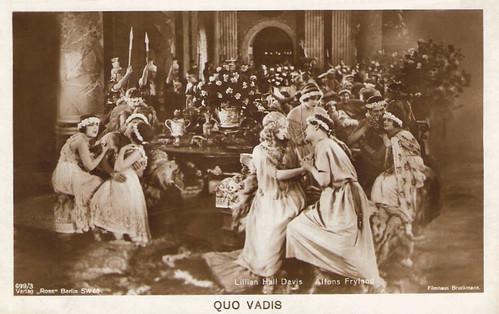
German postcard by Ross Verlag, no. 699/3, 1919-1924. Photo: Filmhaus Bruckmann. Publicity still for Quo Vadis? (Georg Jacoby, Gabriellino D'Annunzio, 1924-1925). Here, Marcus Vinicius (Alphons Fryland) tries to seduce the chaste Lygia (Lilian Hall-Davis) during an orgy at Nero's palace.
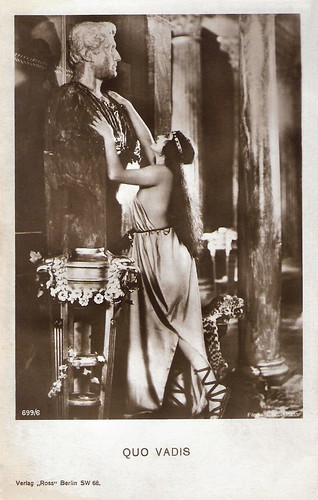
German postcard by Ross-Verlag, Berlin, no. 699/6,1919-1924. Photo: Filmhaus Brückmann. Publicity still for Quo Vadis? (Gabriellino D'Annunzio, Georg Jacoby, 1924) with Rina De Liguoro as Eunicu/Eunice.
Where Are You Going?
Quo vadis is Latin for 'Where are you going?' and alludes to the apocryphal acts of Peter, in which Peter flees Rome but on his way meets Jesus and asks him why he is going to Rome. Jesus says "I am going back to be crucified again", which makes Peter go back to Rome and accept martyrdom.
Quo vadis? tells the love story between a young and beautiful Christian woman, Lygia, and a military tribune and Roman patrician, Marcus Vinicius. The story takes place in the city of Rome under the rule of emperor Nero around AD 64.
Immediately after author Henryk Sienkiewicz got the Nobel Prize for Quo vadis?, Pathé Frères produced the first screen version, Quo vadis? (Lucien Nonguet, Ferdinand Zecca, 1901).
Ten years later Italian director Enrico Guazzoni made a colossal epic starring Amleto Novelli and Gustavo Serena which focused primarily on huge spectacle. The results of his Quo vadis? (1913) at the box office quickly proved it a smashing success.
Throughout the world, Quo vadis? became popular not only among readers but also among fans of the new phenomenon, cinema.
The third film version, Quo Vadis? (1924-1925) was directed by the Italian Gabriellino D' Annunzio and the German Georg Jacoby. The producer was grand old man Arturo Ambrosio of the Unione Cinematografica Italiana, an Ufa-like or Universal-like merger of many Italian pre-war companies.

Italian postcard by Ed. A. Traldi, Milano, no. 651. Photo: Lilian Hall-Davis as Licia in Quo Vadis? (Gabriellino D'Annunzio, Georg Jacoby, 1924-1925).
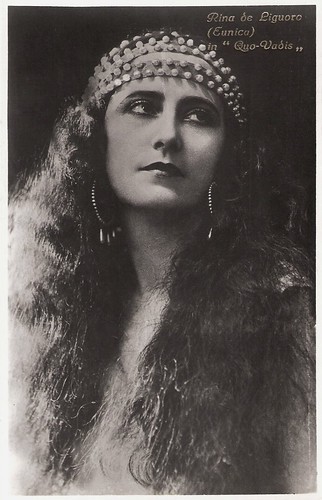
Italian postcard by Ed. G.B. Falci, Milano. Photo: Rina De Liguoro as Eunicu/Eunice in Quo Vadis? (Gabriellino D' Annunzio, Georg Jacoby, 1924-1925).

Italian postcard by Ed. A. Traldi, Milano, no. 662. Photo: Elga Brink as Domitilla in Quo Vadis? (Gabriellino D'Annunzio, Georg Jacoby, 1924-1925).

Italian postcard by Ed. A. Traldi, Milano, no. 663. Photo: Elena Sangro as the Empress Poppea in Quo Vadis? (Gabriellino D'Annunzio, Georg Jacoby, 1924-1925).
A Stellar Cast
The historical epic was shot in Rome with a stellar cast of international silent stars. One of the brightest stars of the British silent cinema, Lilian Hall-Davis, and Austrian actor Alphons Fryland played the two young lovers Licia (Lygia in the novel) and Marcus Vinicius.
The German actress Elga Brink appeared as Domitilla.
Italian actor André Habay portrayed Marcus'uncle Petronius, a member of Nero's court who uses his wit to flatter and mock him at the same time.
Italian diva Rina De Liguoro played Petronius' slave Eunice who later on becomes his mistress and dies with him.
And then there was the famous star of the German silent cinema, Emil Jannings, who was cast as the emperor Nero.
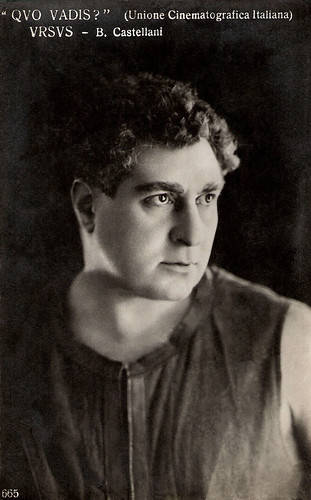
Italian Postcard by Ed. A. Traldi, Milano, no. 665. Photo: Bruto Castellani as Ursus in Quo vadis? (Gabriellino D' Annunzio, Georg Jacoby, 1924-1925).

Italian postcard by Ed. Romeo Biagi, Bologna, no. 666. Photo: Unione Cinematografica Italiana. Alphons Fryland as Vinicius in Quo Vadis? (Gabriellino D' Annunzio, Georg Jacoby, 1924-1925).
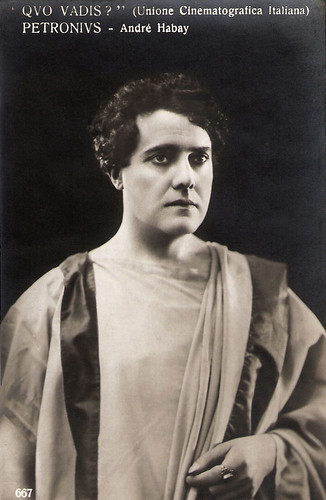
Italian postcard by Ed. A. Traldi, Milano, no. 667. Photo: André Habay as Petronius in Quo Vadis? (Gabriellino D'Annunzio, Georg Jacoby, 1924-1925).
Streaks of Sadism and Nudity
Quo Vadis? had its Roman premiere in March 1925. The producer had tried to equal the earlier version of 1913, adding enormous sets, designed by sculptor and architect Armando Brasini, and streaks of sadism & nudity.
Anyhow, the 1925 version didn't have the worldwide success of Enrico Guazzoni's earlier film. For various reasons: people were a bit bored with epic films and the censor had ordered cuts. The producer almost went bankrupt over copyright claims he all had to pay.
It didn't help that the lion tamer Alfred Schneider was convicted because one of his circus lions had bitten and killed an extra.
Still a fascinating film, especially for the performances of Emil Jannings as the evil emperor Nero, Elena Sangro as the empress Poppea and Bruto Castellani as the strong man Ursus. Castellani had performed the role before in the 1913 version of Quo Vadis?
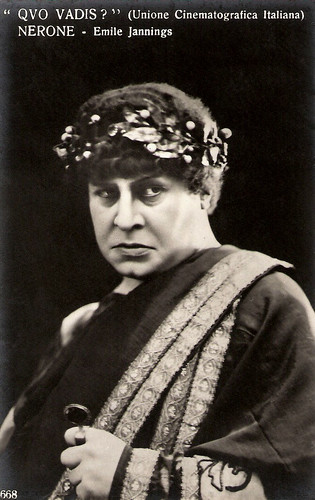
Italian postcard by Ed. A. Traldi, Milano, no. 668. Photo: Unione Cinematografica Italiano. Publicity still of Emil Jannings as Nero in Quo Vadis? (Georg Jacoby, Gabriellino D'Annunzio, 1924-1925).

Italian postcard by Ed. A. Traldi, Milano, no. 669. Photo: Gino Viotti as the leacherous and treacherous Greek Chilo Chilonides in Quo Vadis? (Gabriellino D'Annunzio, Georg Jacoby, 1924-1925).
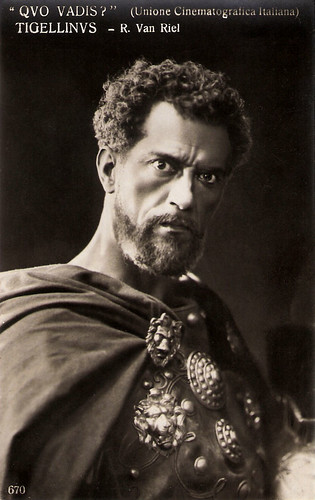
Italian postcard by Ed. A. Traldi, Milano, no. 670. Photo: Raimondo Van Riel as Nero's evil general Tigellinus in Quo Vadis? (Gabriellino D'Annunzio, Georg Jacoby, 1924-1925).
Magnificently Restored
In his review at AllMovie, Hal Erickson calls Quo vadis?'a splendidly lavish production': "Emil Jannings, to whom subtlety was a stranger, tackles the role of Nero with lusty abandon, making this already larger-than-life historical personality even more so. The subsequent Hollywood popularity of Jannings prompted a reissue of Quo Vadis? in 1929, reportedly with a newly recorded musical score."
A few years ago, Quo Vadis? was restored by the Dutch Filmmuseum (now Eye Institute), based on various existing copies. This restored version had its 're-premiere' at the Bologna film festival Cinema Ritrovato in 2002.
The note on IMDb about the low quality of the film is exaggerated, as well as the note that film historians consider the 1913 version as lost. That version was magnificently restored in 1997 by, again, the Dutch Filmmuseum and shown on several festivals including Bologna.

Italian postcard. Photo: UCI (Unione Cinematografica Italiana). Publicity still of the scene of the kidnapping of Lygia in Quo Vadis? (Gabriellino D'Annunzio, Georg Jacoby, 1924-1925).

German postcard. Photo: Filmhaus Bruckmann & Co. A.G. Postcard showing the huge threedimensional set of the palace of Nero in Quo vadis? (Gabriellino D'Annunzio, Georg Jacoby, 1924-1925). The film sets were designed by R. Ferro and G. Spellani.

For years, only a small statue of Henryk Sienkiewicz could be found in the same corner in Villa Borghese (Piazzale Ferdousi) in Rome. Now there is this giant, created by Polish sculptor Czeslaw Dzwigaj.
Sources: Hal Erickson (AllMovie), Marcin Kukuczka (IMDb), Wikipedia and IMDb.